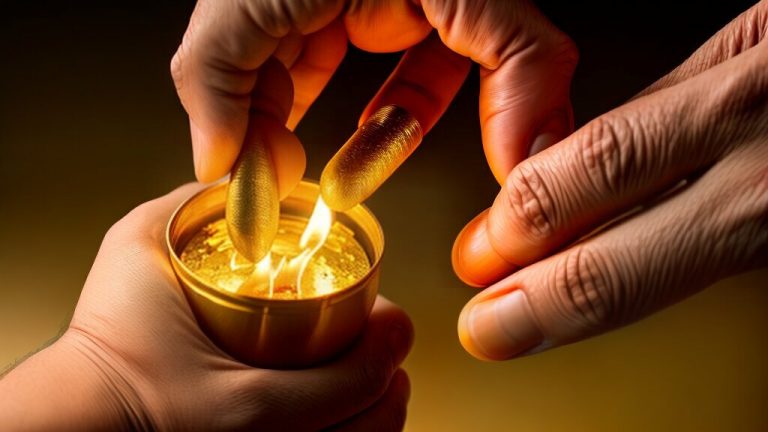Gold is one of the most precious metals in the world. However, it’s also one of the most commonly counterfeited, making it crucial to verify gold’s realness before buying or selling it. Using a lighter to test gold is a simple and popular method that can provide quick results. In this article, we’ll explore the basics of gold testing with a lighter and provide step-by-step instructions on conducting the test and analyzing the results.
Whether you’re a golf enthusiast, a jewelry collector, or a potential buyer, learning to check if gold is real with a lighter can save you from falling victim to scams and ensure that you’re getting the real value for your precious metal.
Key Takeaways
- Verifying gold’s authenticity is crucial to avoid scams and ensure its value.
- Using a lighter to test gold is a simple and popular method.
- Creating the correct test environment and understanding the basics of gold testing are essential for accurate results.
- Analyzing the test results and considering additional factors can further confirm gold’s realness.
- Knowing how to spot fake gold and when to seek professional help can also be helpful.
Understanding the Basics of Gold Testing
Gold testing with a lighter is a simple and accessible way to determine the authenticity of your gold items. The basic principle behind this method is that gold has a high density and, as a result, a high melting point. When exposed to heat, genuine gold will not change color or shape, making it resistant to the flame of a lighter.
Since gold is an excellent conductor of heat, it will quickly absorb the heat from the lighter. If the gold is accurate, it will not react to the flame and will retain its appearance. If the gold is fake, it may discolor or melt due to the lower melting point of other metals.
It’s important to note that this method is not foolproof and may only work for some gold items. For example, gold alloys or surface coatings can affect the testing accuracy, so it may be necessary to use additional testing methods or seek professional help.
Preparing the Test Environment
Creating the right conditions for the test before conducting the DIY gold authenticity test with a lighter. This will ensure a safe and accurate identification of real gold with a lighter.
Firstly, find a well-ventilated area to conduct the test. This will prevent the accumulation of harmful fumes or smoke. Secondly, gather the necessary materials for the test. You will need a clean surface to rest the gold item, a safe container to hold the substance, and a lighter to apply heat to the gold.
It is important to note that safety precautions must be taken when conducting this test. Avoid direct contact with the flame and keep a fire extinguisher or water nearby in an emergency. Using gloves to prevent accidents or skin irritation is also recommended.
Conducting the Lighter Test
Once you have prepared the test environment, you are ready to conduct the lighter test. Follow these easy steps:
- Hold the gold item securely with a pair of pliers or tweezers, ensuring not to damage its surface.
- Apply the lighter’s flame to a specific area of the gold item. The ideal spot is usually on the back or inside of the article, as it may leave some discoloration or marks.
- Observe the reaction of the gold to the heat. If the gold is genuine, it will not react to the flame and will maintain its shine and color. If it is fake or gold-plated, the heat will cause discoloration or tarnishing, revealing the underlying material.
Applying the flame for a few seconds and moving it consistently over the same spot is essential, ensuring a more accurate test. If the gold passes this test, it is most likely genuine gold. However, it may not necessarily mean it is fake if it fails, as other factors could affect the test results.
Analyzing the Results
After conducting the lighter test, it’s essential to analyze the results accurately to determine the gold’s authenticity. Here are some possible outcomes and what they may indicate.
- No reaction: If the gold piece does not react to the lighter flame, it is likely pure gold. However, it’s crucial to note that some counterfeiters may use non-reactive metals like tungsten to create a fake gold piece that gives this result. So, conducting other tests or seeking professional help to verify the gold’s authenticity is always best.
- Discoloration: Any discoloration or change in the gold’s color after applying the flame may indicate that the gold is not pure or mixed with other metals. In this case, conducting additional tests or seeking professional help to determine the gold’s composition is advisable.
- Soot: If the gold piece leaves a black soot mark after the flame test, it indicates that it is not pure and contains other metals like copper or brass. Again, additional testing or professional help may be necessary to determine the actual composition of the gold.
It’s important to note that the lighter test could be better, and other factors may affect the outcome, such as surface coatings or impurities in the gold. Therefore, it’s always best to conduct multiple tests and use different methods to confirm the gold’s authenticity.
Factors to Consider for Accurate Testing
While using a lighter to test gold authenticity can be a simple and helpful method, several factors are considered to ensure accurate results.
One important consideration is the presence of gold alloys, which are familiar in jewelry and other gold items. Alloys can affect the gold’s melting point and density, potentially interfering with the lighter test. To minimize this factor, test an area with the highest gold content possible, such as a clasp or a link.
Another factor to consider is the presence of surface coatings or impurities that may affect the gold’s reaction to heat. If the gold appears to have a coating or plating, try to scratch it off before testing. Additionally, avoid testing gold that appears discolored or has spots, as they may indicate impurities that can interfere with the test.
Finally, it is essential to recognize the limitations of using a lighter as a gold authenticity test. While it can provide a quick and easy way to verify real gold, it could be more foolproof and should be used with other tests and evaluations. If you need more clarification about the validity of your gold item, seek professional help or use more advanced testing methods for a more accurate assessment.
Tips for Spotting Fake Gold
Using a lighter to test gold is helpful, but it’s not the only way to determine if your gold is real. Here are some additional tips to help you spot fake gold:
- Check the weight: Real gold is dense and heavy, so if the item feels too light, it’s likely fake or has a low gold content.
- Inspect for consistency: Real gold has a consistent color and texture throughout the item, while fake gold may have spots or discoloration.
- Look for markings: Authentic gold items typically have markings indicating their purity level, such as “14K” or “18K”. It could be a red flag if there are no markings or if they look suspicious.
- Test with a magnet: Gold is not magnetic, so if your item is attracted to an appeal, it’s likely not real gold.
- Consider the source: If you’re buying gold from an untrusted source or at a suspiciously low price, it’s safer to assume it’s fake until proven otherwise.
Remember to use these tips in addition to the lighter test to make a more informed judgment on your gold’s authenticity.
Ensuring Authenticity: When to Seek Professional Help
Although using a lighter to test gold authenticity is an effective and convenient method, there are situations where seeking professional help is recommended. If you have doubts about your test results or if the item in question holds high sentimental or monetary value, it is best to evaluate it with an expert.
Professional gold testing services offer advanced testing methods that can provide a more accurate and comprehensive analysis of the item’s authenticity. These methods may include X-ray fluorescence (XRF) analysis, acid testing, or electronic conductivity testing.
If you decide to seek professional help, make sure to choose a reputable and experienced service provider. Look for certifications from recognized organizations, reviews from previous customers, and a transparent pricing policy. Be prepared to provide detailed information about the item, such as its weight, purity, and origin, to ensure the most accurate evaluation.
Remember that verifying the authenticity of your gold item is crucial to avoid scams and protect its value. Don’t hesitate to seek professional help with any concerns, especially for valuable or sentimental items.
Conclusion
In conclusion, verifying the authenticity of gold is essential to avoid scams and ensure the value of your precious metal. Using a lighter as a preliminary testing method can quickly and easily determine whether your gold item is real or fake.
Remember to create the right conditions for the test, including a well-ventilated area and proper safety precautions. Conduct the test carefully and observe the expected reactions and signs to look for. Analyze the results and consider additional tests or professional evaluations if necessary.
It’s also essential to consider factors affecting the test results, such as gold alloys, surface coatings, and impurities. Additionally, be aware of common signs of counterfeit gold and seek professional help, especially for valuable or sentimental gold items.
By following these tips and applying the knowledge gained, you can protect yourself from counterfeit gold and ensure the authenticity and value of your precious metal.

I’m Alfred Davis, and I’m all about lighters. Hailing from the great state of Texas, USA, I’ve cultivated a deep passion for these fascinating gadgets. With years of hands-on experience and a burning curiosity (pun intended), I’ve become an expert in all things related to lighters.
My journey with lighters began as a hobby and quickly became a full-blown obsession. I’ve explored the diverse world of lighters inside and out, from classic Zippo designs to modern plasma arc models. I’ve tested, tinkered with, and even collected rare pieces while learning the intricate mechanics and unique histories behind each one.
Through my writing, I aim to share my knowledge, insights, and reviews to help you make informed decisions about choosing the perfect lighter. Whether you’re a seasoned collector or just looking for a reliable fire source, I’ve got you covered. Join me in unraveling the fascinating realm of lighters right here at LightersInfo, where ignition meets expertise.
Alfred Davis

